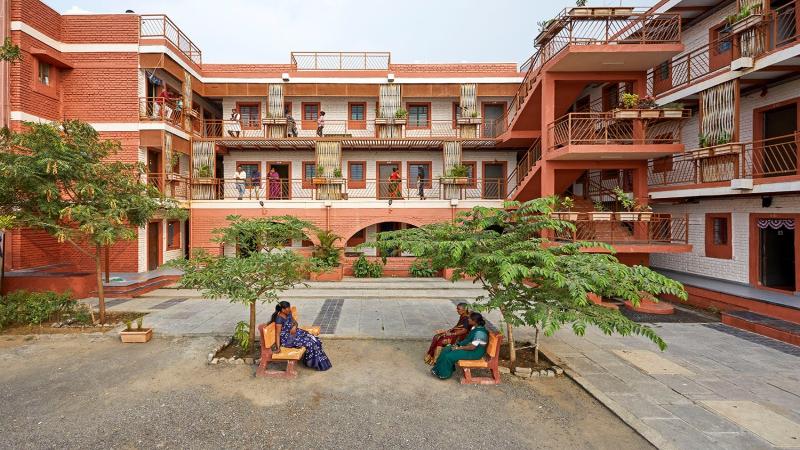
With rapid urbanisation and a growing population, India faces a pressing need for affordable and sustainable housing. The Pradhan Mantri Awas Yojana (PMAY) by the Govt. of India aims to address the country’s housing shortage by providing millions of low-income homes to urban migrants and the poor. The Govt. of India has also set up the Global Housing Technology Challenge to provide innovative solutions to large-scale housing issues. One of the key issues of mass-housing in a country like India would be maintaining comfortable temperatures or thermal comfort indoors.
Researchers from the Indian Institute of Technology Bombay (IIT Bombay) and Community Design Agency, Mumbai have developed a new method that can help choose wall materials that maintain comfortable indoor temperatures in naturally ventilated homes. They used a numerical and simulation-based technique called Computational Fluid Dynamics (CFD) to explore the relationship between wall materials, variations in airflow, and thermal comfort. The researchers chose local and eco-efficient options such as burnt clay bricks and AAC blocks that reduce environmental emissions and transportation costs. Their findings can improve living conditions and occupant well-being even for low-income housing in India. The study was published in the journal Energy and Buildings.
Thermal comfort directly impacts the health, well-being, and productivity of individuals. India’s tropical climate, with its extreme heat and humidity, makes living conditions tougher without proper airflow. The effects of global climate change, such as severe heat waves and urban heat island phenomenon, further exacerbate these conditions.
“Construction materials play a major role in defining the quality and livability of the building, and it is important to make sure that mass housing projects adopt the right materials that provide comfortable living at a reasonable cost,” says Prof. Albert Thomas of IIT Bombay, who led the study.
Building envelopes, which include roofs, walls, floors, windows, doors, and foundations, act as barriers between the indoors and outdoors and significantly affect heat transfer. Wall materials, which typically account for over 40% of building envelopes, are crucial in determining indoor temperatures by absorbing, storing, and emitting heat.
“This study is particularly relevant since low-income housing in India is still predominantly naturally ventilated spaces with little to no access to HVAC (Heating, Ventilation, and Air Conditioning) systems, unlike the Western world. Through this study, we have attempted to use a real-life case study and modelled the same to understand the impact of material selection on thermal comfort in indoor spaces,” remarks Dr. Vandana Padmanabhan, an author of the study and Materials and Technology Lead at Community Design Agency.
The study proposed a framework that simulated indoor temperatures by considering different wall materials and analysed the airflow patterns within naturally ventilated housing units using CFD modelling techniques. While concrete bricks might be the most economically viable, they do not provide the best thermal insulation and are environmentally hazardous. The researchers chose aerated autoclaved concrete blocks (AAC), compressed stabilised earth blocks, burnt clay bricks, and compressed fly ash blocks for the simulation. Airflow patterns included conditions such as “all windows open and doors closed” and “all doors and windows closed” and similar building operating conditions. Using CFD modelling, the study mapped the temperature distribution and airflow within the housing units in these scenarios.
The researchers found that AAC blocks outperformed other locally available materials, such as compressed stabilised earth blocks and compressed fly ash blocks, in insulating the indoors. They could maintain cooler temperatures owing to their low thermal conductivity and specific heat capacity, which reduces heat transfer. The selection of wall materials depends on factors such as local availability, construction methods, and structural needs.
“AAC blocks have lower compressive strength than some of the other wall materials. Solutions to this include reinforcing AAC with additional structural supports or combining it with other materials to maintain structural integrity while benefiting from its thermal insulation properties,” explains Tripti Singh Rajput, the lead author of the study and a PhD student at IIT Bombay.
To encourage universal adoption of AAC blocks, enabling mass production and wider availability can help.
Prof. Thomas shares that “given the number of buildings to be built in India in the next few decades, if a policy change can be brought out for a wider adoption of materials such as AAC blocks for government-driven low-income housing and mass housing projects, it will result in mass production and hence, lead to the reduction of the overall cost”.
The study also highlighted the differences in global and Indian building standards and guidelines. Compressed stabilised earth blocks and compressed fly ash blocks did not meet the recommended values for thermal performance as per building design guidelines for acceptable thermal conditions, such as the EcoNiwas Samhita and ASHRAE 55. However, according to India-specific standards suggested by the Indian Model for Adaptive Comfort in - Naturally Ventilated (IMAC-NV) and Residential (IMAC-R) models, the indoor temperatures of all the tested wall materials were found to be within the comfortable range under different operating scenarios.
The thermal comfort metric used in the study was based on a solution that assumes that the different parameters, like temperature and airflow, are stable. Upgrading to a solution that considers varying states of different parameters and includes more dynamic and precise personal and environmental parameters of thermal comfort could further strengthen the framework's robustness.
Talking about the future of the research, Prof. Thomas says, “More research can be done on generalising the results across different building types and climatic conditions, which will help in easy decision-making and policy formulation across different building types and scenarios.”






